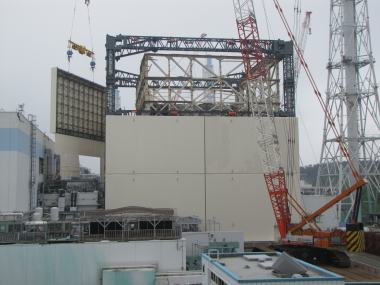A four-year process is planned to rebuild the cover over Fukushima Daiichi 1, equipping it to remove used reactor fuel still stored there.
 |
| Seen here during construction in September 2011 the cover was made from pre-fabricated panels attached to a steel frame enveloping the reactor building and the remaining steel supports of its roof (Image: Tepco) |
Tokyo Electric Power Company (Tepco) will take away the roof of the temporary cover structure that was put in place to reduce radioactive emissions to air in the six months after the accident in 2011. This will give the company's engineers vertical access to the reactor service floor, from which they will remove the steel debris left behind by the hydrogen explosion - some of which lies in the used fuel storage pool and is a priority to remove.
Tepco will then install equipment for handling the used fuel before strengthening the surrounding area for heavy machinery and rebuilding a new version of the cover. The entire process is planned to start in the middle of this year and continue for some four years before the removal of used fuel actually begins.
During the time the cover is open it is inevitable that more radioctive particles will escape the building. To mitigate this, Tepco will reduce the size of openings leading from the interior of the building (for example former stairwells) and will spray dust control agents during debris removal. Ventilation will be suspended for for the rebuilding work, but monitoring of radiation levels will continue.
Adding the cover in October 2011 reduced the amount of radioactivity escaping the building by a factor of four compared to levels immediately after the accident. This was complemented by gas control systems which further reduced releases by a factor of 30. Opening the cover will cause releases will increase, said Tepco, but only to contribute a total of 0.001 milliSieverts per year to dose rates at the site boundary because the gas control systems will still be in place.
Fuel the priority
Containing the vast majority of radioactivity at the site, the stored used fuel at each reactor unit is eventually to be placed into containers and transferred to the site's shared fuel pool. This is a common priority for all four damaged reactors, each of which is proceeding at a different pace towards the goal due to each one's unique circumstances.
Researched and written
by World Nuclear News




_16403_79272.jpg)


_69218.jpg)

_76087_55556.jpg)



